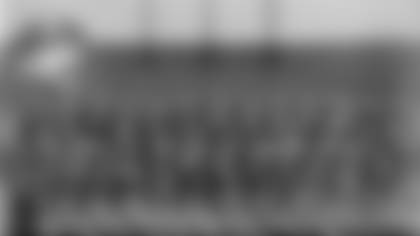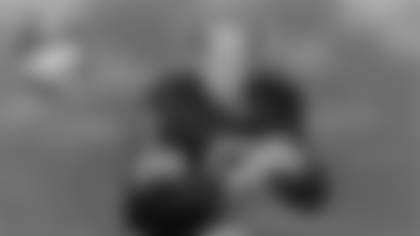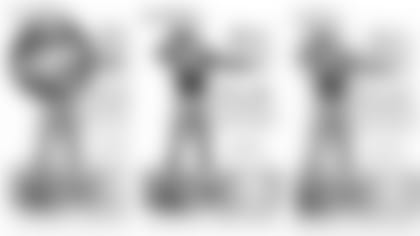Chuck from Richfield, WI
I loved Mike's nugget on how the Bears have enacted a self-fulfilling prophecy of doom by having 14 retired jersey numbers and banning the retirement of more in the future! I think our six retired jerseys are appropriate with Aaron Rodgers soon-to-be seven. I thought the Packers would retire Curly Lambeau's No. 1 jersey during the 100-year team anniversary. Any insights why not? I can't recall even one player in my lifetime who has ever worn jersey No. 1 for the green and gold. Wes has deferred the question to you about Paul Hornung's No. 5 and Lambeau's No. 1.
First, I agree with Mike and Wes about the Packers taking a more selective approach to retiring numbers. The fewer the better with Rodgers, as you noted, being next on the list. It should be the ultimate honor that a team bestows on one of its players. But harsh reality is that during their lean years in the 1950s and again in the 1970s and '80s, the Packers were not only losers on the field, but there also was no end to the off-the-field blunders committed by their general managers, head coaches and corporate officers. How they handled their retired numbers was a prime example and why their decisions have been a source of controversy for more than 65 years. Let's take them one by one. Don Hutson's number was the first to be retired, but what would figure to be a special moment turned into an afterthought. On Dec. 2, 1951, six years after he played his last game, Hutson's No. 14 was hastily retired at halftime of a game against the New York Yanks at old City Stadium. After Hutson and five other Packers greats were given blankets for their selection to the now defunct Helms Athletic Foundation Hall of Fame, a reenactment of the Arnie Herber-to-Hutson passing combination and the presentation of a scroll by Green Bay Mayor Dominic Olejniczak to Hutson, second-year coach Gene Ronzani with little fanfare and few words handed Hutson a No. 14 jersey to symbolize the retirement of his number only moments before the start of the second half. The next day, Lee Remmel, then writing for the Green Bay Press-Gazette, devoted one sentence to the retirement of Hutson's jersey deep into his sidebar on the game. A year later, a group of fans scheduled Tony Canadeo Day for the Packers-Dallas Texans game on Nov. 23, and announced they planned to retire his No. 3 in a pregame ceremony. It was Canadeo's 11th and final season, and his final home game. On game day, Canadeo was given a Chevrolet station wagon, a television set, a champagne bucket and a scroll of the names of the fans who donated to the cause. But there was no ceremony or mention of his number being retired. Why not? I could find no explanation in the Packers' corporate minutes of executive committee and board of directors meetings or anywhere else. But I think I found a clue in a Press-Gazette story that ran a little more than two weeks before the game. The paper made it clear that Tony Canadeo Day was being organized by fans with the Packers' blessing, but it "is not sponsored by the Packers." Canadeo was certainly an outstanding player, but maybe more so an all-out competitor and fan favorite. Organizers of the event admitted they were paying tribute to him "because he had always given something extra on the field in addition to giving Packers fans something to yell about" during hard times. What's more, I think it can be safely assumed that Tony Canadeo Day and the halftime show when Hutson was honored were held during late-season games against two one-win teams – the Yanks finished 1-9-2; the Texans, 1-11 – to try and boost the size of the crowds when the Packers were struggling to survive, maybe more so than for any other reason. Attendance for the 1951 game against the Yanks was 14,297, almost 11,000 below capacity; while the crowd for Tony Canadeo Day was only 16,340. Here's another educated guess about why Canadeo's number wasn't retired as planned. Charlie Mathys was the Packers' starting quarterback for most of four seasons in the 1920s, an influential member of the board of directors for more than 50 years after he retired and essentially a lifelong resident of Green Bay who never missed a game into the 1970s. Mathys told Remmel in the 1960s that he considered Verne Lewellen, a former teammate, the greatest player in Packers history. Jug Earp, who played for the Packers from 1922-32, was the team's director of public relations when Hutson's number was retired and Canadeo's wasn't. He played almost his entire career with Lewellen, who was also a member of the Packers' board at the time of those events. Several other former Packers greats who stayed in the Green Bay area and were former teammates of fullback Clarke Hinkle and Hutson also went on record after Canadeo retired saying they believed Hinkle was the greatest player in Packers history. This is pure speculation, but my hunch is that the fans' plan to retire Canadeo's number met with considerable resistance from alumni and others. But if that was the case, why is No. 3 retired today? Two years later, Canadeo was a salesman and stopped to watch a training camp practice in Stevens Point, Wis., when he spotted No. 1 draft pick Veryl Switzer wearing No. 3 and "nearly swooned" in the words of the Press-Gazette's Art Daley. Trainer Bud Jorgensen assured Canadeo that Switzer would be reassigned No. 27 before the season started. In early March 1955, less than a year later, Canadeo was elected to the Packers' board and then, three years later, to the executive committee, where he was a strong voice and respected member through the 1990s, when the Packers first published their list of retired numbers. Let's not forget, too, that Vince Lombardi, Canadeo's good friend, issued No. 3 to kicker Ben Agajanian for the final four regular-season games and the NFL championship in 1961. "… Vince didn't give a damn," Canadeo said years later. However, Lombardi cared enough about the honor to announce on July 10, 1967, at the Packers' annual press party, that he was retiring Hornung's No. 5. Remmel covered the event for the Press-Gazette and quoted Lombardi as saying: "I might say in this connection we will not have a number five this year, and so far as I'm concerned, there will never be another number five in Green Bay." What's more, Remmel did not equivocate in his story. He flatly stated that Hornung joined Hutson and Canadeo as the only Packers to have their numbers retired. "The 31-year-old Golden Boy is the first player to be so honored in Lombardi's regime, now in its ninth season," Remmel wrote. The eight-column headline over his story read: "Vince Tabs Hyland Potential Starter; Retires Paul's '5'". However, the Milwaukee Sentinel and Milwaukee Journal and many other Wisconsin papers ran Ken Hartnett's Associated Press story on the press conference and that seems to have created some confusion. On one hand, Hartnett also unequivocally wrote, Hornung's number "will be retired." But the Lombardi quote in his story differed from Remmel's. According to Hartnett, Lombardi said, "As long as I'm in Green Bay, No. 5 will not be used." My apologies if all these twists and turns are wearing you out, but the story doesn't end here. Six years later, the Packers drafted quarterback Jerry Tagge in the first round. He had worn No. 14 at Nebraska and was assigned it before the start of training camp. Former teammates of Hutson and longtime fans objected, claiming No. 14 was retired. But not surprisingly, considering the actual act of retiring Hutson's number might not have lasted two minutes, nobody could remember when. Hutson said he thought his number was retired by Curly Lambeau shortly after he quit playing in 1945 and some of his teammates echoed the same belief. Why Lambeau didn't retire Hutson's number before his bitter divorce from the Packers in early 1950 is a mystery. Anyway, at that point, coach and general manager Dan Devine had members of the organization research the subject. Their findings? No official record of the Packers' retired numbers existed in the team's Lambeau Field offices. They also found that other players had been assigned the number in training camp over the previous 20 years, but nobody had worn it in a game that counted. As a result, Devine said he was convinced Hutson's number was retired. Tagge was given No. 17 instead. "Hutson's Number Retired by Packers, for 2nd Time," was the headline over sportswriter Terry Bledsoe's story in the Journal. "As far as informal historians can remember, Hutson's number is the only one formally retired by the Packers, although Vince Lombardi made a singlehanded retirement (of Hornung's) when he was coach and general manager of the club," Bledsoe wrote. Highly respected by peers in the newspaper field and also well thought of in NFL circles, which later landed him jobs with the NFL Management Council, as assistant general manager of the New York Giants and as GM of the Buffalo Bills, Bledsoe had investigated the subject well enough to get the story right, a true rarity at the time. A year later, the Packers acquired veteran receiver Dick Gordon on waivers from the Los Angeles Rams, and he requested No. 5. But, reportedly, veteran equipment manager Dad Braisher refused to give it to Gordon because of Lombardi's decree. Only a week earlier, the Packers also had officially retired Bart Starr's No. 15, finally with a proper ceremony. Thus, the retired number controversy was topical again. "That brought the question: How many other numbers have the Packers retired?" the Journal's Chuck Johnson asked. "No one seems to know for sure. Maybe everybody's lost count." Remmel disagreed. Despite writing seven years earlier that the numbers worn by Hornung and Canadeo had been retired, Remmel now backtracked in his "Personality Parade" column, where he stated "only one number ever had been officially retired … '14.'" In 1985, Forrest Gregg gave over-the-hill quarterback Vince Ferragamo No. 5 with two games remaining in the season. Ferragamo also wore it in 1986. Gregg, who had to know but never corrected the false statement that Lombardi had called him his finest player, said he had no problem unretiring Hornung's number after 20 years. "It's fine with me," Gregg answered when he was quizzed about it. "We need to revive No. 5. Maybe some of that charisma of Paul Hornung's will rub off on the rest of us." Was jealousy a factor in Gregg's decision? Only he would know. But Lombardi actually had called Hornung the "greatest player I ever coached" in a widely covered speech; whereas Gregg, during the 10 years since he was hired as coach in Cleveland, had lived the lie about something Lombardi never said – or at least I've yet to find any evidence of Lombardi ever saying anything of the kind, at least publicly about Gregg. In 1987, Gregg issued No. 5 to both rookie quarterback Don Majkowski and strike-replacement quarterback Willie Gillus. Majkowski, at least, had enough appreciation for Packers history that he asked to switch to No. 7 before his second season out of respect for Hornung. However, that made no difference to Lindy Infante, who seemed to care less about the Packers' great history, during his four-year stay. In 1988, he gave No. 5 to kicker Curtis Burrow, whose career lasted all of one game. In 1990, the Packers listed their retired numbers in their media guide for what appears to be the first time. The list included Canadeo's No. 3, as well as 14, 15 and Ray Nitschke's No. 66, which was retired in 1983. Hornung's No. 5 wasn't included. Remmel was the Packers' executive director of PR at the time, but I'm not sure if he had a say in the decision or not. Regretfully, I never asked him. If he did, it marked the third time he had changed his mind about Nos. 3 and 5. It would be another 13 years before the retired numbers were first displayed on the façade in the north end zone of Lambeau Field following the 2003 completion of the stadium's renovation. Again, Canadeo's number was included, but not Hornung's. Bob Harlan was president when the numbers were first printed in the media guide and also when they were unveiled inside the stadium, but he said he couldn't remember why Canadeo's number was included and not Hornung's.
Lou from Kohler, WI
I consider it a shame that the Packers did not retire Paul Hornung' No. 5 before he passed away in accordance with Vince Lombardi's wishes. It reminds me of MLB not putting Ron Santo into the HOF before he passed, but right afterwards, which was a crime.
I agree. If Canadeo's No. 3 is retired, then Hornung's No. 5 should be, too. There's little difference between the two circumstances. If anything, Lombardi, while he was still coach and general manager, officially announced Hornung's number was being retired, whereas I've never seen any official announcement by anyone associated with the Packers that Canadeo's number was being retired. I fully understand Mark Murphy's reluctance to do what wasn't done in 1990 and 2003. He had nothing to do with turning what should have been a sacred honor into a perpetual debate, if not an unforgiving screwup. As I've told him and others, I believe he has done more to preserve the great history of the Packers franchise than any president in team history. His instructions to me from the beginning and through the Packers Hall of Fame renovation, the Lambeau art project, the "Legacy" documentary, our 100th season celebration and, most recently, our book on the definitive history of the Packers have never changed: Just make sure you get our history right. Sadly, it had become a muddled mess over the years, although I want to make clear I'm not casting aspersions on Remmel, who covered or worked for the Packers for more than 60 years and was our first official historian. Lee and I talked about this often. He admitted he never did any research on early Packers history and just took the word of Lambeau and George Calhoun, the Packers' co-founder and his former co-worker at the Press-Gazette, even though he admitted that Lambeau couldn't be trusted to tell the truth. Lee had a great memory and knew what he had lived, which was many more years of Packers history than I can claim. At the same time, Lee was a minimalist when it came to writing about early Packers history because he also knew what he didn't know. Lee was a stickler for accuracy when I worked with him at the Press-Gazette, and, more than anything, he was a storyteller. Believe me, I'll always be indebted to him for the countless stories he shared with me. But back to Hornung's number. I think we're all fortunate that the Packers' general managers since 1992 – Ron Wolf, Ted Thompson and Brian Gutekunst – have had a great appreciation for Packers history and have not issued No. 5 to any player during the regular season, obviously with the blessings of Harlan and Murphy. In fact, Wolf claims he did retire it. He told me he instructed Red Batty and his equipment staff to never issue No. 5. I'm not into curses, but it has crossed my mind that the "Curse of No. 5" might be why the Packers suffered three of their most inept seasons when Gregg and Infante issued it to borderline players and have won the Vince Lombardi Trophy only twice since he died. After all, Lombardi considered Hornung his greatest player and who would know better than him? In fact, I'm not so sure if he had lived and run the Packers for another decade or more if he would have retired any other number. I have little doubt, he'd be deeply dismayed if he could see the north wall in Lambeau Field with no No. 5 – his wishes ignored.
Sam from Antigo, WI
What is the story on jersey No. 1? It is never issued. Why?
No. 1 was worn by Lambeau in 1925 and '26. Nobody wore it before and nobody has worn it since. But how many players have you seen on other teams wearing No. 1? Or even other low-single-digit numbers? Charlie Mathys wore No. 2 in 1925-26 and nobody else wore it until it was given to Mason Crosby in 2007. No. 4 was last worn by blocking quarterback Herm Schneidman in 1937 and not again until backup quarterback Chuck Fusina wore it in 1986. End Ray Riddick wore No. 5 in 1940-41 and then nobody wore it until Hornung in 1957. If anybody remembers these two names, you're a cinch to win Packers' Jeopardy. Back Mal Bross wore No. 6 for two games in 1927 and the next player to wear it was punter Ryan Flinn for two games in 2005. When I was kid and first started following the Packers from the mid-1950s to mid-1960s, nobody wore single-digit numbers. Besides Hornung's No. 5, the only other player to wear one was Agajanian in 1961. I might have known from pictures that Packers Hall of Famer Bob Forte wore No. 8 from 1946-53, but that was really before my time. I know some people have pitched in recent years for Lambeau's number to be retired, but I can't remember anyone ever bringing that subject up until the last 10 years or so. Lambeau wore No. 1 for only two years and he was on the downside of his career when he did. Keep in mind, too, he was inducted into the Pro Football Hall of Fame as a coach only. I think the Hall got it wrong, considering George Halas was inducted as both a player and coach. But I'm not sold on retiring Lambeau's number. If having your number retired is the ultimate honor for a player, having a stadium named after you is the ultimate honor multiple times squared. Plus, there's a giant-sized statue of Lambeau at the stadium's entrance. In his case, retiring his number would almost be insignificant by comparison.















